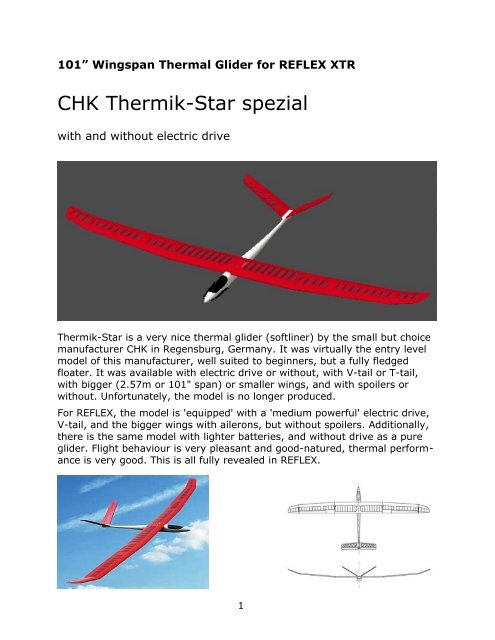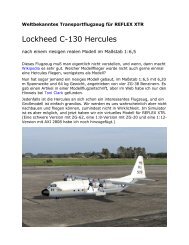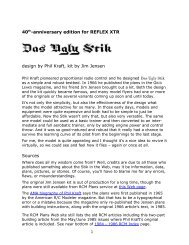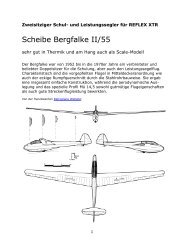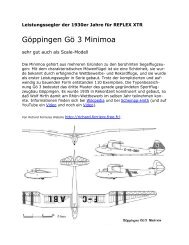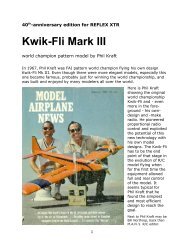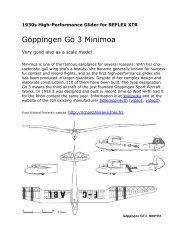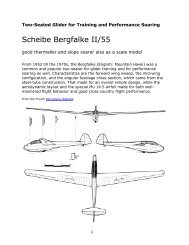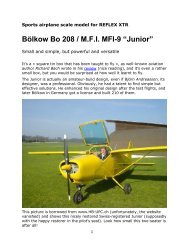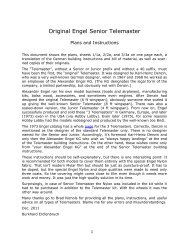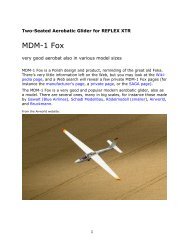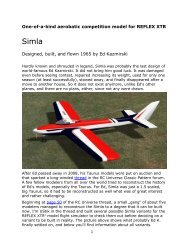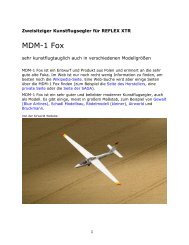CHK Thermik-Star spezial
CHK Thermik-Star spezial
CHK Thermik-Star spezial
- No tags were found...
Create successful ePaper yourself
Turn your PDF publications into a flip-book with our unique Google optimized e-Paper software.
101” Wingspan Thermal Glider for REFLEX XTR<strong>CHK</strong> <strong>Thermik</strong>-<strong>Star</strong> <strong>spezial</strong>with and without electric drive<strong>Thermik</strong>-<strong>Star</strong> is a very nice thermal glider (softliner) by the small but choicemanufacturer <strong>CHK</strong> in Regensburg, Germany. It was virtually the entry levelmodel of this manufacturer, well suited to beginners, but a fully fledgedfloater. It was available with electric drive or without, with V-tail or T-tail,with bigger (2.57m or 101" span) or smaller wings, and with spoilers orwithout. Unfortunately, the model is no longer produced.For REFLEX, the model is 'equipped' with a 'medium powerful' electric drive,V-tail, and the bigger wings with ailerons, but without spoilers. Additionally,there is the same model with lighter batteries, and without drive as a pureglider. Flight behaviour is very pleasant and good-natured, thermal performanceis very good. This is all fully revealed in REFLEX.1
101” Wingspan Thermal Glider for REFLEX XTR <strong>Thermik</strong>-<strong>Star</strong>The diagram shows the calculated speed polar for gliding. Both horizontaland vertical speed are shown in m/s. By calculation, <strong>Thermik</strong>-<strong>Star</strong> shouldhave a lowest sink rate of 0.38 m/s at an airspeed of 8.3 m/s and the shallowestglide of 0.43 m/s at 10.0 m/s. That is a 23.2 glide ratio and a decentvalue for such a model (and for the 1.7 kg weight). The values are notmeasured, but the model in REFLEX gives the impression of being that good.Thermals with 1 meter per second vertical speed are sufficient to let themodel go up and away. It will be difficult to land it gracefully against thermals.Good tricks are slowing down (nose up, the model may drop the nose,but not a wing) and sideslip (rudder is effective enough). Sometimes, substantialrudder is required together with ailerons, even though there is somedifferential. It's useful to have a mixer automatically combining 70% rudderwith full aileron. Circling in thermals is nearly self-stable.In REFLEX, ailerons deflect also as flaps (flaperon), both up and down. In theparameter file, maximum deflection is set to 30 degrees to have spoilers likeon the real model. But up deflection has no effect in REFLEX, so just usedown deflection instead. The model will be not fully controllable and you willhave to use rudder instead of ailerons. Since REFLEX version 5.05 thecontrols of the model may be assigned to transmitter channels. In this case,all is working like in reality (see below).2
101” Wingspan Thermal Glider for REFLEX XTR <strong>Thermik</strong>-<strong>Star</strong>The drive of the REFLEX model is set up like my real model. It has a brushedmotor Plettenberg HP 200/25/5 with 4.4:1 gear, an aero-naut CAMcarbon14x8" folding propeller, a Schulze smart-45bo ESC and a 7 cell Sanyo RC-2400 NiCd battery. This drive was recommended by (and bought from) <strong>CHK</strong>and is very efficient. So a full battery will give many climbs to thermal altitude.The diagram shows the calculated thrust/speed curve of the drive. Thrust Tis in Newton and speed v is in m/s. The normal speed range of <strong>Thermik</strong>-<strong>Star</strong>should be 6 to 15 m/s, best is then 11 m/s. In REFLEX, the calculated greencurve is approximated by the red line. This seems to give a realistic flightbehavior, like that of the real model.The electric drive not only replaces a high-start, but also spoilers (works onlyfrom REFLEX version 5.07 on). It's easier to land 'on the spot' and at all saferto land with a drive, provided you save some battery capacity for that. Unfortunately,in REFLEX only total flight time is counted, not power-on time,so you should increase the now set 6.5 or 15 minutes, respectively, to theduration of a thermal flight. The drive's weight seems to be good for themodel since it's 'penetration capability' in strong wind is better with it. Handlaunching the model requires at least 6 to 8 meters per second launch speed,but 10 m/s are better.3
101” Wingspan Thermal Glider for REFLEX XTR <strong>Thermik</strong>-<strong>Star</strong>That even applies to the pure glider without drive, which is here set to a 500g lower weight. Given 1.5 to 2 m/s 'Thermal current' in Reflex, it's easy toreach thermals from 10 m 'Launch initial altitude'. By the way, the new glidersound is assigned to this model, but the electric powered variant has still theoriginal drive sound without glider noise.For more information in German on my real model see my Web page. InEnglish, there were only the web pages of the manufacturer <strong>CHK</strong>. Somereports on the model could be found in the Web using search engines, butmost of them were in German.The REFLEX modelsThere are three basic models: „<strong>Thermik</strong>-<strong>Star</strong> E“ (with an electric drive withNiCd batteries), „<strong>Thermik</strong>-<strong>Star</strong> E new“ (with LiPo and NiMH batteries), and„<strong>Thermik</strong>-<strong>Star</strong> G“ (pure glider without drive). They are flown with standardtransmitter settings.The demo flights „<strong>Thermik</strong>-<strong>Star</strong> E“ und „<strong>Thermik</strong>-<strong>Star</strong> G“ (hit F9 in REFLEX)show the model’s impressive thermalling and slope soaring performance.There are only two minor problems regarding these models. One problem isthe motor run time of the electric model. After the pre-set 6.5 or 15 minutesthe drive is dead in REFLEX, no matter whether you used it or exploited thermals.Therefore you should set the „Engine running time“ in REFLEX (hitF11) to the planned duration of a flight, so you may use the drive for thelanding procedure.The other problem regards the effect of ailerons deflected up as spoilers(spoilerons). Normally in REFLEX, the ailerons can only act like flaps (flaperons)when deflected down. In this case there’s virtually no aileron effect. Inthe 5.05 Version of REFLEX this problem is solved by assigning transmitterchannels to model controls and generating the control deflections usingtransmitter mixers.Now there are the models „<strong>Thermik</strong>-<strong>Star</strong> E tx“, „<strong>Thermik</strong>-<strong>Star</strong> E new tx“, and„<strong>Thermik</strong>-<strong>Star</strong> G tx“ („tx“ for „transmitter“). All these models are equallyprepared for use with transmitter mixers. Ailerons and virtual flaps both have30° maximum deflection, the two V-tail controls 25° in the REFLEX parameters.In REFLEX, under „Control...“ (menu „Model“ or Shift-F7) you’ll find thefollowing assignment, suitable for Multiplex transmitters, but to be adaptedto other transmitters. The Multiplex transmitters always have the two-servoaileron mixer assigned to channels 1 and 5, and the V-tail mixer to channels2 and 3. Other transmitters are different or adjustable.4
101” Wingspan Thermal Glider for REFLEX XTR <strong>Thermik</strong>-<strong>Star</strong>Control Channel reversedAileron left 1Aileron right 5 XV-tail left 2V-tail right 3 XMotor 4Channels 5 and 3 are reversed here because the Multiplex transmitters needa special servo setup. This may be different for other transmitters as well.Anyway, you have to set up your transmitter for 100% (of 30°) up and 22%down maximum deflection of the ailerons. There should be some differential,so the ailerons go down only 22% and up only 48% as ailerons. When theailerons are deflected 100% up as spoilerons, one of the ailerons should godown for aileron effect.The two V-tail halves should deflect 100% (of 25°) for rudder effect, but only72% for elevator effect. Besides, they should go up 35% when spoilerons aredeflected to counteract their pitching-down moment. No such correction isneeded for running motor. But 70% rudder with 100% aileron deflection(Combi mixer) is recommended.This all is based on recommendations of the model manufacturer <strong>CHK</strong>. It willgive a somewhat sluggish control response of the model that is not unpleasantfor thermal flying, though. In any case, with these control settings theREFLEX model behaves very realistically.Enjoy!Burkhard Erdlenbruchmailto:Burkhard@Erdlenbruch.dehttp://time.hs-augsburg.de/~erd/Modellflug/textReflex.htmlMore REFLEX models and the latest versions are on my pagehttp://time.hs-augsburg.de/~erd/Modellflug/textDownloads.shtml2003 - 20145


